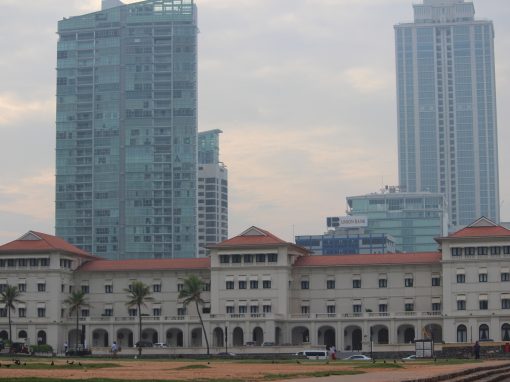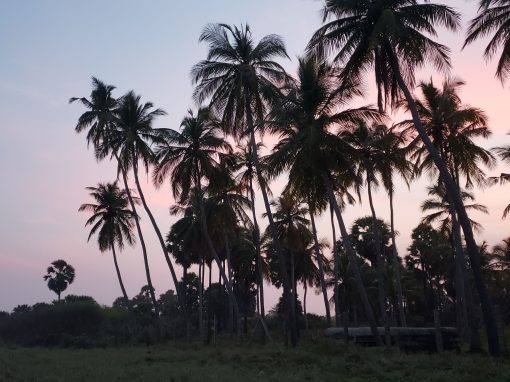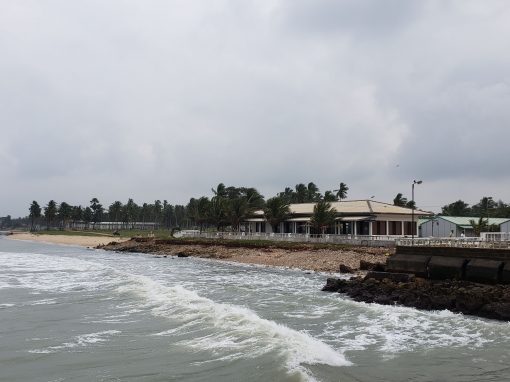Part II: Eastern Province
Uppuveli is now a popular tourist destination but was once a wasteland. (Photo © Stephen Cook)
The tall grass surrounding the long-abandoned bunker is littered with wrappers and empty beer cans. But the cracked concrete structure once held lethal purpose, maintaining watch over the sandy beach before it.
“Because this was a place of the LTTE,” explains Vaseikaran Prathapan, sitting on the veranda of the nearby Palm Beach Resort. “They came in the night time, bringing weapons and everything from this beach.”
Prathapan has lived here almost his entire life. Born in Jaffna, his family moved to Trincomalee when he was only two after the Sri Lankan army recaptured that city in 1995.
Now nearly 30 years later, the nearly six-foot jolly giant manages this hotel in a suburb north of Trincomalee Town proper, an area at various points in history occupied by the LTTE, the Indian Peacekeeping Force and the Sri Lankan Army.
“So they will bring (weapons) here and they will supply them to Trincomalee,” he says. “This land, when it was a junkyard, we couldn’t come to this place easily – they had a barrier here.”
A decade ago, when the war ended, the small suburb of Uppuveli was mostly empty land. Even today, there are still tracts of empty swamp more often frequented by wild animals than people.
(And bothersome monkeys, who had just deprived Palm Beach of its internet by chewing through some cable)
But these few square kilometres that once housed only three hotels has exploded into a hub of dozens of guesthouses and small restaurants. Although official capacity estimates for such a localized area are not available, locals say that in the high season between May and July, guests from all over Sri Lanka and parts of Europe flock to the area to try their hand at paddleboats and enjoy the sandy beaches.
The Palm Beach Resort, Prathapan tells me, has 19 full-time staff during those months. When I visit in December, they’re down to only seven.
Many other hotels and guesthouses simply close their doors in the off-season and a few surrounding ventures have clearly been abandoned for years, a sign of the sustainability problems faced by locals trying to enter the tourism industry here.
The scene of the fish market in Trincomalee Town. Fishing is still one of the primary livelihoods in the district. (Photo © Stephen Cook)
EASTERN GATEWAY
Trincomalee Town is one of the largest natural harbours in the world, ten times the size of Colombo and once the lynchpin of the state ambitions of the LTTE; mentioned under different names in ancient Hindu texts, the Koneswaram temple daily attracting crowds of people from all throughout South Asia. In 2006, it was the first true battle site for the re-eruption of the civil war after the Tigers cut off the water supply to lands under the control of the Sri Lankan Army.
Now the district is the focus of an ambitious master plan, commissioned by the central government and crafted by a Singaporean consultancy firm, that will transform Trincomalee into the “Eastern Gateway of Sri Lanka,” an international tourism hub that includes a yacht marina at Deadman’s Cove, a national cricket stadium, a cruise ship terminal and an aquarium.
By 2050, that is: for now it is still a town of around 100,000 with a 10 per cent district poverty rate, the primary industries still sustenance fishing and agriculture. The riches of that megacity are still far off, the district’s local strategic plan for 2018-2022 painting a stark portrait of unemployment and poverty as well as the need for reconciliation, reintegration and peace building.
“As a tourism-oriented city, Trincomalee tourism sector is seen as the main contributor to the economic development,” reads the district plan.
“We have to increase the tourists here because the thing is most of the growth is coming from the Middle East, Western countries and Asians,” says Mohamed Fayis, acting director of the Eastern Province Tourism Bureau, wearing a fitted patterned shirt and trim mustache. “Those people are focused on the Southern Province.”
“But they are not concerning the North and Eastern Provinces.”
We meet in the café of the Trinco Rest House in central Trincomalee Town. Across the street from the spot, where the Indian Peacekeeping Force once made its headquarters, a white and gold trimmed gate guards city hall. Less than a block away, families (and several cows) gather on Dutch Bay Beach to enjoy the sunshine and view of the cliff of Trincomalee where sits the ancient Koneswaram Temple.
But even this popular local park is imbued with the legacy of the war: here, 13 years ago, five Tamil students were killed by Special Forces in front of a statue of Mahatma Gandhi. The case caught the attention of international media, and the victims became known as the “Trinco Five.”
No one has yet been held accountable for the extrajudicial executions.
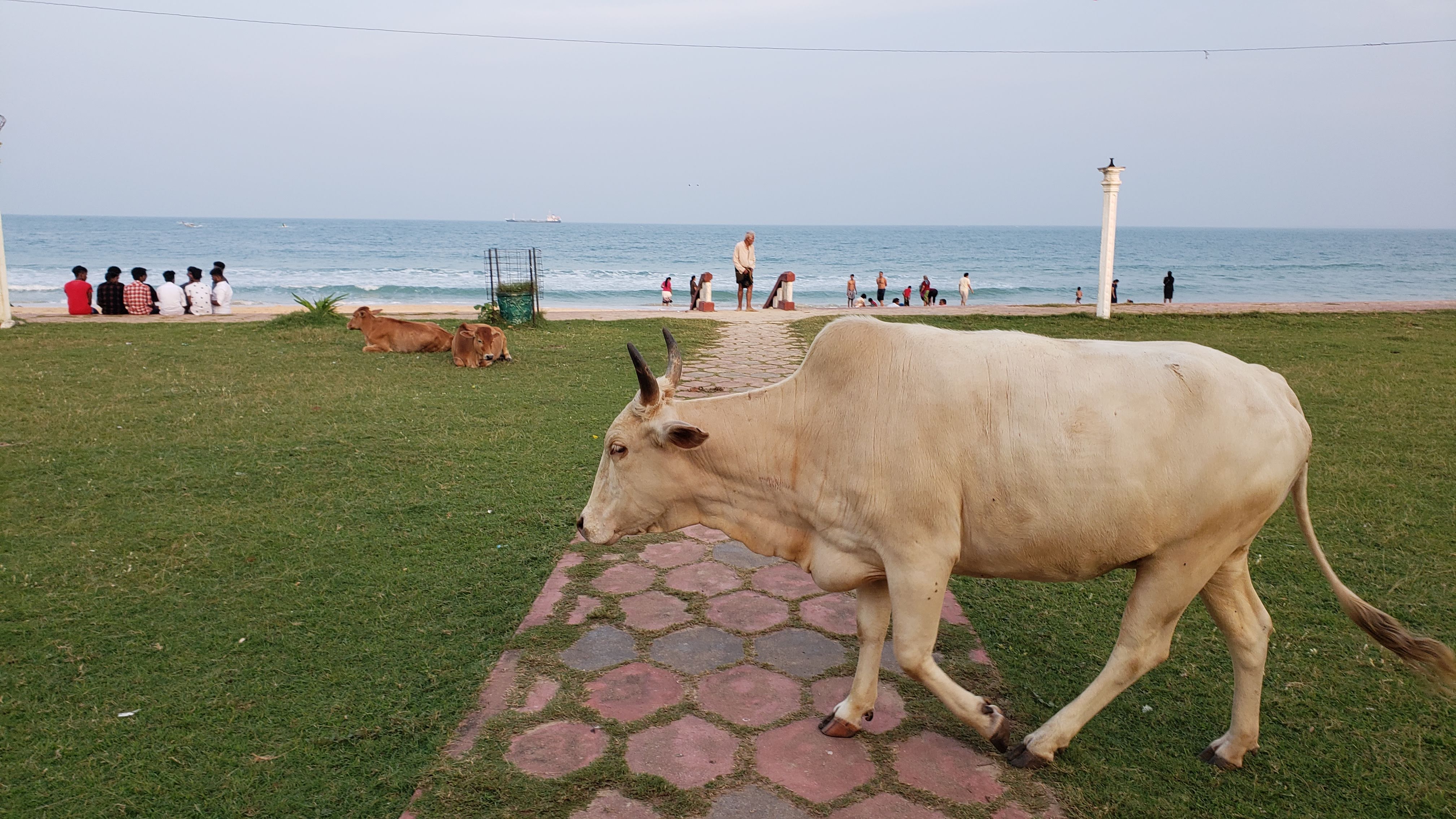
An ox walks the green of Dutch Bay Park, a popular local beach. (Photo © Stephen Cook)
Like many civil servants, Fayis wears a few different hats. He’s served for several years within the health department of the Eastern Province and was only appointed to the tourism bureau in October. As its first director he still struggles to find ways to grow the industry.
There are many reasons why the province continues to lag in its growth of tourism, he says, much of it connected to the lasting effects of the war: poor infrastructure, distrust of government projects by locals, and even a lack of technological knowledge.
“After the civil war 30 years ago, the mentality of the people was different from others,” he says. “We didn’t know the new technology earlier than 2009, we couldn’t understand what is in the internet and email and how we can live with those things.”
The legacy of war hurts more than just promotion. Communities are heavily segregated according to their ethnic background – neighbourhoods and villages are often arranged into Sinhalese, Tamil or Moorish enclaves. It is a division further accented by distrust as social programs struggle to encourage interaction and communication between the various communities.
At Kanniya Hot Springs, those ethno-religious tensions take on new dimensions as local Tamil Hindus set themselves against the Archaeological Department.
Fayis, a Muslim himself, says he struggles to involve his own community in developing the kind of cross-cultural, year-round attractions that could break the boom-and-bust cycle of the tourist season.
But plans must also consider the people already there.
“All the beautiful beaches … (are) their livelihood,” he says. “We cannot immediately move those people to somewhere else.”
Fishing boats of Kuchchaveli stored by the Salpayaru Bridge. (Photo © Stephen Cook)
LAND FOR TOURISM
In the case of Kuchchaveli, a coastal town northwest of Trincomalee Town, the interruption of livelihoods has nonetheless followed development. Located just north of Trincomalee, the establishment of a tourism zone of approximately 500 acres stretching eight kilometres down the coast resulted in the displacement of local fishers and farmers.
According to a report from the European minority rights organization the Society for Threatened Peoples, in 2010 around 300 people were ordered to leave the land by the navy. Two years later, a petition was sent by the locals to the government requesting the land’s return. They received a response saying the building containing land titles was destroyed in a fire and there was no official proof of their ownership.
Fishermen from local villages must now walk several kilometres to a crowded beach beside the Salpayaru Bridge to access their boats, allowing for little opportunity to establish efficient nets in the shallows of the beach.
Despite the nearly 10 years the site has been allocated for tourism development, few resorts have actually been built. The slow progress is at least partially owing to disagreements over leasing prices between the SLTDA, government, and investors, according to reporting from the Sri Lankan national newspaper the Daily Mail.
Kuchchaveli is an exemplar of failed tourism development in the Eastern Province negatively disrupting livelihoods. But 150 kilometres south in the Batticaloa district of the Eastern Province, the success of the Pasikudah resort has been no less disastrous for some locals.
In the 1970s and early 1980s, the precursor to the SLTDA operated a resort comprised of 171 rooms in the area for which “the local community surrounding the bay earned a living primarily from tourism,” according to a development plan from 2009. But that resort shuttered its doors in 1989 when hostilities escalated.
For the fishermen of Pasikudah and nearby Kalkudah, the war was devastating.
“Wartime we faced problems – we lost our properties, we lost our work, and we lost our nets,” the village president, Kanagaradnam Rajan, tells me. We meet at the small plot of land that serves as their dock, dozens of small boats crammed into a 350-metre area with only one rickety building. To the north is land claimed by the development board and to the south are pristine beaches overlooked by resorts
The fisherfolk are feeling the squeeze.
“The tourist board is coming, saying we need that land – you are to go to other places,” says Rajan.
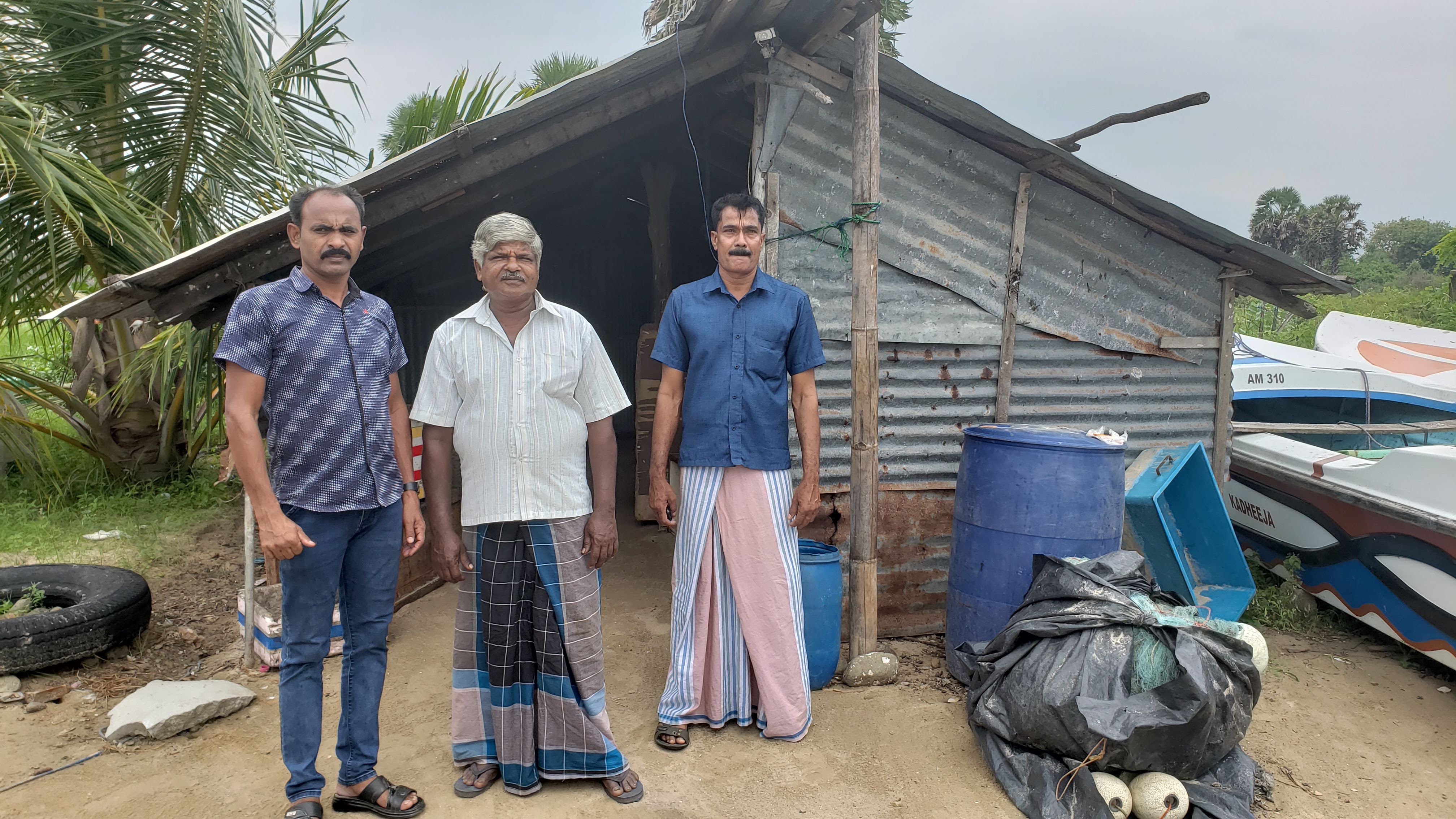
Kaneshamoorthy Vimalkas, left, Velayutham Vinayakamoorthy, centre, and Kanagaradnam Rajan, right,
expressed their concerns for fishing and land-use rights along Pasikudah. (Photo © Stephen Cook)
LEGALIZED ROBBERY
Although the situation in Pasikudah is especially dire because of the history of displacement caused by both war and the 2004 tsunami, this destructive method of tourism development is present throughout the country.
This is at least partially due to land usage laws dating back to 1950 wherein most land is still technically controlled by the government and is metred out on a permit basis. But land can also be seized by the government if declared in the public interest, including for the development of tourism, but this method does require certain legal proofs.
After the 2004 tsunami, 15 areas were zoned for tourism.
“Pasikudah is one of the tourism sites they proposed,” explains Herman Kumara, national convener for the fisherfolk rights group, the National Fisheries Solidarity Organization (NAFSO).
“They don’t bother about other resource users who are depending on the same resources, the same land and waterways for their livelihood,” he says.
Kumara has been a long-time member of NAFSO, which works with marginalized groups to promote human rights and sustainable development. It has made him a target before: in 2012, following a fishing protest that led to the death of one man after police opened fire, Kumara was blamed by the government for the violence. Friends and neighbors were questioned by authorities during the repressive post-war Rajapaksa regime.
NAFSO has remained active in organizing against mass tourism projects that negatively affect the livelihoods of fishermen living along the coast. Kumara describes an especially egregious case across the country at Kalipitya where 10,000 people were suddenly evicted from their ancestral islands in 2010.
“So this is a very well-planned, legalized robbery – land-grabbing and tree-cutting,” he says. People who have fished or farmed lands for generations do not think they need to prove legal claim to the land, he says, giving the government a window to evict them.
But given Sri Lanka’s strategic trajectory, Kumara says those affected cannot stop tourism development and must instead adapt to it.
“We cannot escape from that so we need to learn how to cope with these things, how to make sure there’s an income for the fisher communities through that.”
Part of this involves organizing fishing communities and protesting against unfair development practices like land-grabbing. But another is simply educating fishermen how tourism could be an additional source of income, particularly during the off-seasons.
Orr’s Hill is an army base that boasts a museum dedicated to the war. (Photo © Stephen Cook)
TOURISM MANEUVER
At Orr’s Hill, the army runs a museum showcasing Sri Lankan and LTTE military equipment. Trained interpreters – soldiers – offer tours around the outdoor facility that also features a pellet shooting range and a café where one can even enjoy a cup of coffee in the shadow of a T-64 tank.
On the peninsula south of the city, the Air Force has established an even more expansive tourism operation. China Bay Air Base includes a golf course, hotel, and the regionally-famous resort, Marble Beach – supposedly named for the visible sheen as the sun hits the water.
But Waapurasa Yaalichipichai remembers it by another name: White Man’s Beach, in reference to the Europeans who once lived there when the land was occupied by the Catholic Church.
I met Yaalichipichai in his home, a small shack of wood and corrugated metal down a dirt road just off the highway running parallel to the Air Force base. White-haired and partially blind due to cataracts, it has been some time since the wiry 79-year-old has fished the waters of Trincomalee.
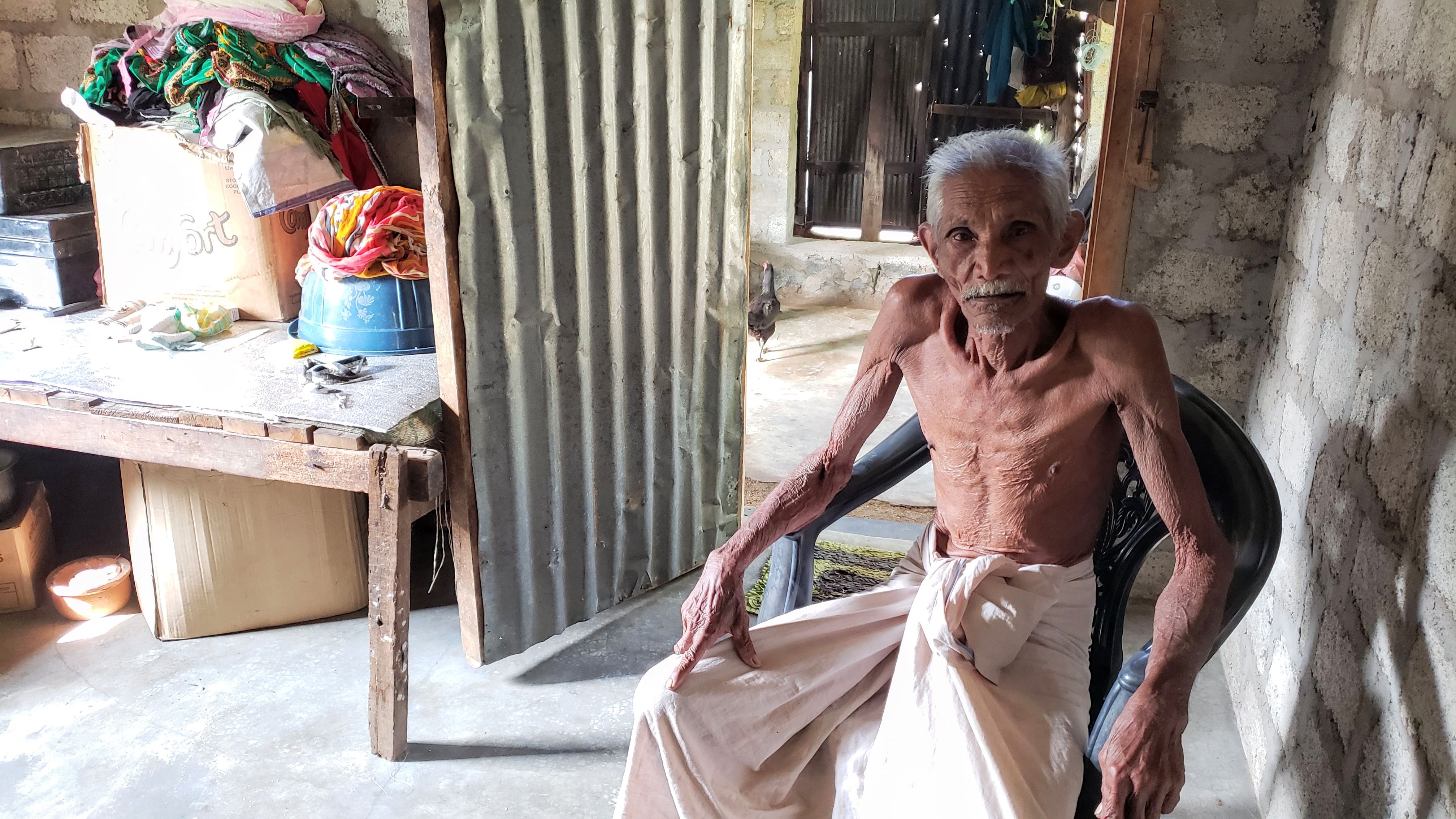
Yaalichipichai, 79, remembers a time when Marble Beach was open for fishermen’s use. Now, it is off-limits and run as a resort by the Air Force. (Photo © Stephen Cook)
But the man is a living library of knowledge of the history of the area and an elder of his Muslim community. His father killed by Japanese bombs, Yaalichipichai worked from a young age as a fisherman. At one point he set up more permanent housing near Marble Beach, even harvesting maize and other crops. When the civil war re-erupted in the late 1980s and the military moved in, the fisherpeople using that area were forcefully evicted despite it being an ancestral fishing ground.
“Now we can’t go there,” says Yaalichipichai. “Or we can go but there’s nothing to do because we can’t do fishing, just to go for fun.”
But even access to Marble Beach comes at a cost of 20 rupees per person, a fee not affordable for some locals.
And Yaalichipichai is destitute even by the standards of the oft poverty-stricken working class, relying on the generosity of family members (some of whom have turned to agriculture rather than fishing). In his unelectrified house, lit at night by small fuel lamps, there is but a single bed and table amid the occasional wandering hen. I don’t ask about plumbing.
Tonight, he will eat only a quarter loaf of bread, a diet that reveals itself in the way the old man’s skin clings tightly to his bones.
Yaalichipichai says his community has never tried to make a legal case for access. How could they? They can hardly afford to live. But even so, he still hopes there can someday be an agreement to allow his people to once again cast nets in the fish-rich waters.
“In the future, we don’t want to disturb them,” he tells me. “Allow us to go fishing and come, we would be grateful.”
But in the Singaporean consultancy’s 2050 strategic plan the area is colour-coded pink: tourism.

